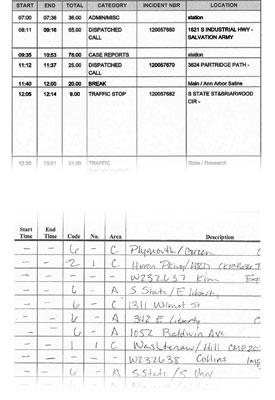Column: When Tech Supports Policy Decisions
When the Center for Digital Government’s Digital Cities Survey ranked Ann Arbor as first in its population category for 2012, I considered this to be terrible news.

Ann Arbor police department old-style, manual officer activity reports (bottom) contrasted with a newer-style, digital records system.
It deprived me of my favorite way give a poke in the ribs to Dan Rainey, who heads up the city’s IT department: “A top 10 finish, huh? So what went wrong? Why not first place?”
Of course, a top ranking on the Digital Cities Survey is not a terrible thing. And by rights, as part of the Dec. 3, 2012 city council meeting report, Chronicle readers might have reasonably expected to see some mention of that first-place award.
That was the meeting when Rainey announced the award, and invited IT staff to the podium to talk about some projects they’ve been working on. Those included a project involving traffic and signal systems that’s connected to the University of Michigan Transportation Research Institute’s smart-vehicle research study. They also talked about a project that will integrate three major software systems at the city: asset management, finance and payroll.
None of that award talk made it into the Dec. 3 meeting report.
Last year, when the merely fifth place Digital Cities ranking was announced, it was also not included in The Chronicle’s council meeting report. As a partial explanation for that omission, I wrote in a subsequent column: “But one reason I don’t mind omitting that kind of award from a meeting report is that it really does not matter to me where Ann Arbor ranks on that survey. What matters to me is the fact that the city’s investments in the realm of digital technology make life in Ann Arbor as a local journalist easier than it would be otherwise.”
That column put a spotlight on some of the city’s digital tools I use on a regular basis that make my life as a journalist easier. This year, I’d like to highlight three digital projects that I think will make life easier and better for citizens and policymakers, too. None of these three projects were mentioned at the Dec. 3 meeting – which is to say that I stumbled across them in my regular travels.
Those three projects are: (1) the transition to a digital platform for submitting site plans to the planning and development department; (2) the integration of a simple button push that Ann Arbor firefighters can use to record timestamps at key points during their response to calls; and (3) conversion of pen-and-paper police department officer activity reports to a digital format.
It’s the third project I am particularly excited about – because of its potential to provide data that will directly affect policy choices made by the city council. That optimism is based in part on the fact that it was cited specifically at a recent city council planning session. The question it will help answer is this: How much time do Ann Arbor police officers have available for proactive policing? [Full Story]



